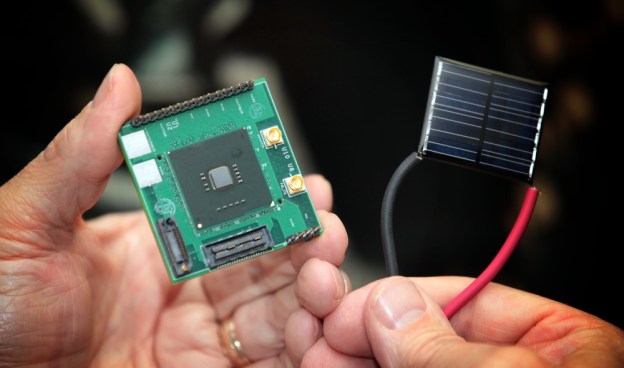
If we can’t make batteries last longer, maybe we should make electronics that require less energy, a lot less. In its new quest to combat ARM in the mobile market, Intel has taken up this mission. On Sept. 15, the chipmaker unveiled and demonstrated a new microprocessor capable of running on “near-threshold voltage (NTV),” which means it can run on almost the bare minimum amount of power required to turn on transistors and “begin to conduct current.” Today, most chips run at about 1V or more, but this chip would run at 10 millivolts, or about one one hundredth the current. More exciting is that this energy savings comes with a “5-10x” improvement over nominal operation.
“This concept CPU [codenamed ‘Claremont’] runs fast when needed but drops power to below 10 milliwatts when its workload is light – low enough to keep running while powered only by a solar cell the size of a postage stamp,” writes Intel in its release. “While the research chip will not become a product itself, the results of this research could lead to the integration of scalable near-threshold voltage circuits across a wide range of future products, reducing power consumption by 5-fold or more and extending always-on capability to a wider range of computing devices. Technologies such as this will further Intel Labs’ goal to reduce energy consumption per computation by 100- to1000-fold for applications ranging from massive data processing at one end of the spectrum to terascale-in-a-pocket at the other.”
The “Claremont” processor is so energy efficient that it could actually be powered by almost anything, including kinetic energy from walking, solar energy, or even a potato. “We used a solar cell in the demonstration to show how little power was required,” Intel spokeswoman Connie Brown told Wired. “But it could run on anything that has power. The key message is the low power and how much more transistors would be power-efficient running at near-threshold.”
Intel Labs also unveiled Hybrid Memory Cube, which has 7-times better energy efficiency than DDR3 memory. Learn more about this collaboration with Micron here.
While we wish battery technology would advance faster, perhaps this is better. How cool would it if all electronics had the 30-day battery life of a Kindle. Or what if your smartphone could be recharged by simply being in your pocket and moving around all day, or maybe by the sun? Count us in on this research.


